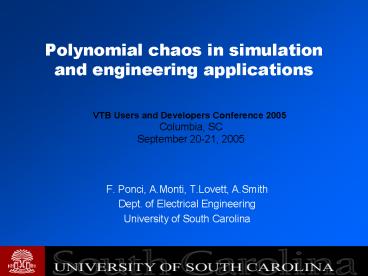Polynomial chaos in simulation and engineering applications PowerPoint PPT Presentation
1 / 24
Title: Polynomial chaos in simulation and engineering applications
1
Polynomial chaos in simulation and engineering
applications
VTB Users and Developers Conference 2005
Columbia, SC September 20-21, 2005
- F. Ponci, A.Monti, T.Lovett, A.Smith
- Dept. of Electrical Engineering
- University of South Carolina
2
Outline of the presentation
- Overview of Polynomial Chaos Theory
- Current research
- Simulation of uncertain system
- Evaluation and propagation of measurement
uncertainty - Control of uncertain systems
- Future Research
3
Methods to handle uncertainty in engineering
modeling
- Traditionally only deterministic mathematical
models - Problems with parameters or inputs equal to
random variables - Monte Carlo method (or other statistical methods,
expensive especially for already large
deterministic systems) - Taylor expansion of the random field (or other
methods limited to small variances, higher order
expansion impractical) - Interval Arithmetic for true worst-case analysis
- Artificial intelligence for qualitative analysis
- Polynomial Chaos expansion
4
The Polynomial Chaos Theory
Brown University
General framework of PCT Application to
differential equations
Polynomial Chaos Theory (PCT)
Wiener
GhanemSpanos
Parameters are random variables with given
probability function
Stochastic solution
5
Generalized Polynomial Chaos
- The key ingredient of the chaos expansion is to
express the random process through a complete and
orthogonal polynomial basis in terms of random
variables. A second-order random process can be
represented as
6
PCT Steps
- Given the uncertain variables in the system with
given Probability Density Function PDF, pick a
polynomial base - Describe the PDFs in the chosen base
- All the variables are described in the new base
- Apply Galerkin projection
- Calculate process output
- From PCT coefficients reconstruct the PDF of the
output variable
7
Selection of the base
e.g. uncertain resistance with gaussian
distribution
8
Stochastic ODE
- Let us consider the following equation
- Where k is a random parameter with a given
distribution and mean value
9
Stochastic ODE
- Apply the generalized polynomial chaos to
variable y(t) and parameter k - And substituting
10
Stochastic ODE
- Projecting on the random space and applying
orthogonality condition - where
11
PCT model
- A model in PCT format is described by a set of
deterministic differential/algebraic equations - The total number of equations is larger than that
of the deterministic problem - In general
u number of uncertain parameters k order of
polynomial expansion n number of state variables
12
PCT for simulation
- Computational advantage
- instead or running a deterministic simulation
thousands of time, we run a larger dimensional
simulation only once - Rich simulation result
- an analytical expression for the PDF of all the
variables is found - Design advantage
- it easily supports incremental elimination of
uncertainty in the incremental prototyping
13
PCT for simulation
Uncertain capacitor voltage
Uncertain inductor current
14
PCT Application to measurements
- Provides an advanced method to combine
measurement uncertainties - Provides an advanced method for uncertainty
propagation in algorithms
15
Uncertainty in measurements
- The uncertainty of a measured variable is a
combination of uncertainties - The uncertainty of an indirect measurement
requires the propagation of measurement
uncertainty through the measurement algorithm - The knowledge of measurement uncertainty is
critical in the measurement-based decision making
processes
16
Example combining different distributions
- Due to the characteristics of the PDFs, the
resulting uncertainty may not be well represented
by a Gaussian distribution (central limit
theorem) - The resulting uncertainty is computed assuming
the central limit theorem holds and with the PCT
17
Example combining different distributions, case 1
- Case 1 central limit theorem holds
Gaussian
PCT
18
Example combining different distributions, case 2
- Case 2 central limit theorem does not hold
Gaussian
PCT
19
PCT in control applications
- May be used in control of uncertain systems
- Procedures may be developed to design controls
with limited sensitivity to system parameter
uncertainty - The optimal control of a buck converter has been
designed as a case study - Resistive load and input voltage are assumed
uncertain
20
Control of Uncertain Systems buck converter
- Let us adopt an average model for the converter
- The state equations look like
21
Control Testing
- Let us now assume to adopt a linear optimal
control approach - A possible cost function can be
22
Applying PCT to the control synthesis
- Let us now suppose to adopt the same cost
function but to define as set of state variables,
the extended set in the PCT - By using the coefficient of the matrix Q we can
give an higher cost to the coefficients related
to uncertainty
23
Experimental results of the buck converter control
Traditional Case
PCT Case
24
Further developments
- Application for monitoring and diagnostics
PCT-based observer, DDDAS - Extension of the control analysis Game Theory
- More complicated cases for the definition of
uncertainty in measurements - Development of new VTB models
- Application on engineering design tolerances and
full design space

